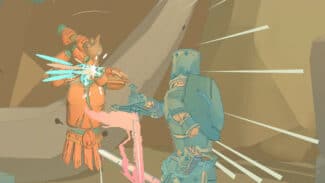The word I keep coming back to with Broken Edge is ‘measurable’.
It’s how Guillaume Perreault Roy, Creative Director at Trebuchet, described the thought process behind the game’s design to me – giving players measurable ways to assess their impact on the flow of the fight. A clash of swords in Broken Edge has a clear outcome – if player one slashes through player two’s weapon, it gets broken off at the point of impact. Player two is left with a maimed, but still usable, weapon – the titular ‘Broken Edge’, if you will. Your weapon becomes similar to a health bar and once it’s depleted down to just the hilt, you only have one last chance to counter against a fatal blow.
This is an easy way to make and measure progress in a fight – the less of your opponent’s weapon left, the more chance you have to swing the tide. There’s also numerical damage values for sword clashes, which flash up at the point of impact, as well as a more traditional sword-shaped health bar that floats above each player too. You’re essentially given multiple quick methods of assessing you and your opponent’s standings mid-fight.
This is just the tip of the iceberg. Broken Edge employs a bunch of new and unique mechanics, in the hope of creating a satisfying system for 1v1 duels. Announced back in June, Fast Travel Games will publish the title when it launches with five classes to choose from later this year.

It’s clear that Trebuchet wants to take on the sword fighting genre with a release that offers high skill ceiling mechanics and potential for high-level competition. The goal is likely to create something for both ends of the gaming spectrum – easy to pick up, hard to master. That being said, there’s enough complexity in the learning curve of Broken Edge to ensure I only scraped the surface in my demo at Gamescom last month with Guillaume.
While an entertaining session, it wasn’t quite enough to get a proper feel for the game’s competitive potential. However, what remains interesting ahead of release is how Broken Edge’s design philosophies are essentially workaround solutions to an unavoidable problem that plagues the entire genre – when two virtual swords clash, nothing physically happens. There’s no resistance or any force feedback to go with the interaction, so any virtual sword fight remains inherently different to one in real life.
There’s no way around this, at least for now, and it’s something that even the biggest VR studios are aware of. It’s likely why Valve avoided melee (and crowbar) combat in Half-Life: Alyx, opting instead for a more gun-centric approach that feels closer to a 1:1 interaction on current VR hardware.
 In the case of Broken Edge, there’s a direct comparison to be made with Ironlights, which released back in 2020. It’s a similar style of multiplayer sword fighting game, but with a somewhat different approach to combat. Duelling in Ironlights involves taking turns to attack or defend and uses a system requiring slow-motion movement and action. It was an admirable attempt, but a solution that never really clicked for me.
In the case of Broken Edge, there’s a direct comparison to be made with Ironlights, which released back in 2020. It’s a similar style of multiplayer sword fighting game, but with a somewhat different approach to combat. Duelling in Ironlights involves taking turns to attack or defend and uses a system requiring slow-motion movement and action. It was an admirable attempt, but a solution that never really clicked for me.
Broken Edge feels similar to Ironlights in some ways, but distinctly different in others. Visually, it’s a much more impressive package – the game’s visuals are stunning, featuring a beautiful pastel colour palette with a distinct art style and memorable character design. In terms of gameplay though, it’s much more fast-paced and encourages engaging in a real-time duel with your opponent. You won’t be feeling that heavy clang of metal in VR anytime soon, so Broken Edge focuses on visualising your impact on the outcome instead.

Each class in Broken Edge also has unique stances and moves that will grant a buff or invoke effects. This should hopefully translate to different strategies across classes, but Guillaume also hopes it will encourage players to embody their classes and engage in a form of roleplay. The more into it you are – getting into stances, dancing around your opponent, strategically moving around each other – the better you’ll play and the more you’ll be rewarded.
For now though, all of the above remains theoretical – it’s still uncertain if Broken Edge will reach the lofty competitive heights that the developers want it to, but the pieces seem to be in the right starting position. It all depends on whether these new mechanics click with a wider audience on release. Plus, there’s many more classes and mechanics to explore than I could fit into one short demo. Ten minutes was just enough to get a taste of what Broken Edge plans to bring to the table – I left eager to dive into the full course.
Broken Edge is coming to Quest 2 and PC VR later this year.




